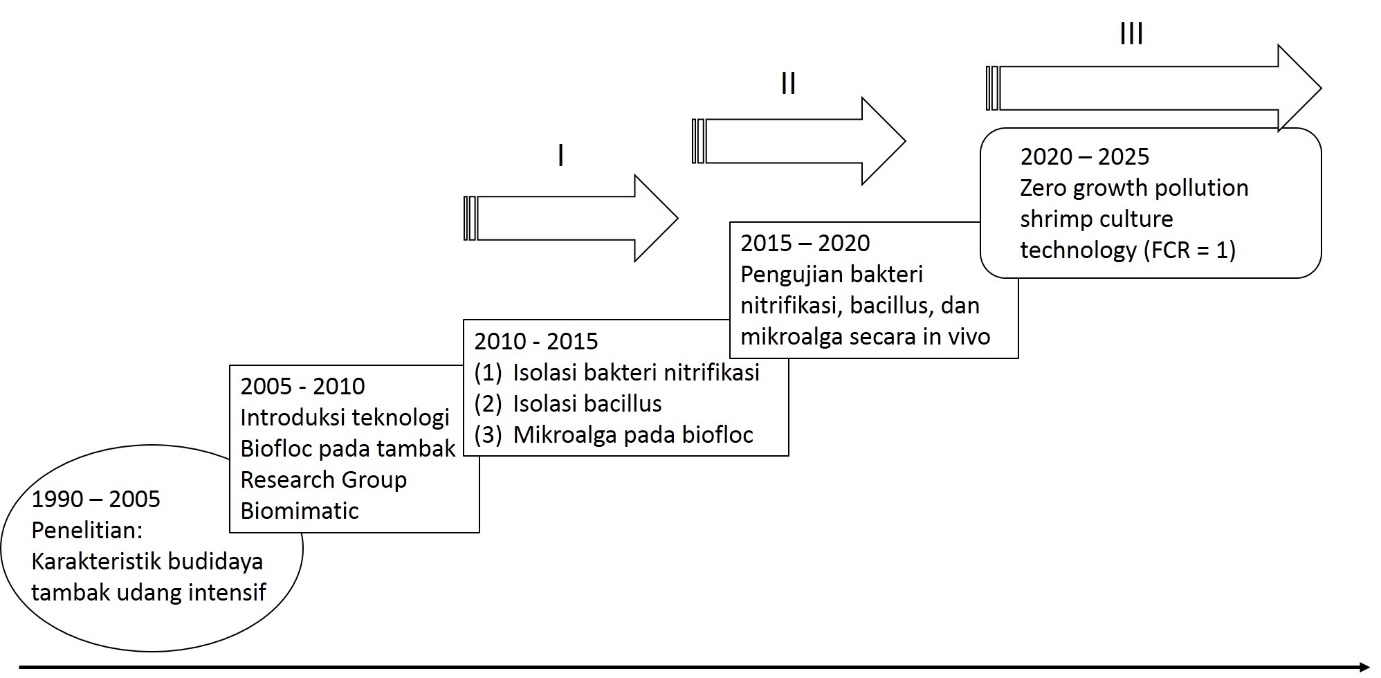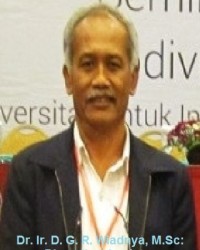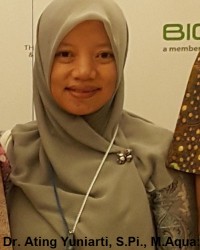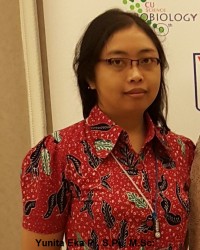ROAD MAP, MEMBER CONTRIBUTION AND PROGRAM REVIEW
Picture 1. Process step of activity and research cooperation included with research result dissemination to reach zero growth pollution shrimp culture technology in years 2020.
a. Research of shrimp culture cultivation
Research of Shrimp culture started in 1990 by 2 researchers who becomes member of Aquatic Biofloc research group.(A.M. Hariati dan D.G.R. Wiadnya). Chain of research done by informal cooperation with two researchers from Wagenigen University Research, Netherlands (J.H. Boon dan M.C.J. Verdegem). Research result of 10 years creates 5 articles which published in International Journal with reputation. The titles are:
- Hariati, A.M., D.G.R. Wiadnya, A. Prajitno, M. Sukkel, J.H. Boon, & M.C.J. Verdegem 1995. Recent development of shrimp, Penaeus monodon (Fabricus) and Penaeus merguensis ( de Man ), culture in East Java. Aquaculture research 26; 819-829
- Hariati, A.M., D.G.R. Wiadnya, M.W.Tanck, J.H. Boon & M.C.J. Verdegem, 1996a. Penaeus monodon (Fabricus) production related to water quality in East Java, Indonesia. Aquaculture Research 27;255-260
- Hariati, A.M., D.G.R. Wiadnya, M.W. Tanck, J.H. Boon & M.C.J. Verdegem, 1996b. Pond production of Penaeus monodon (Fabricus) in relation stoking density, survival rate and mean weight at harvest in East Java. Aquaculture 27, 277-282
- Hariati, A.M., D.G.R. Wiadnya, M. Fadjar, S. Muhammad, R. Faber, J.H. Boon & M.C.J. Verdegem, 1998a. The Impact of Penaeus monodon (Fabricus) postlarvae stocking density on production in traditional fishpond system in East Java, Indonesia. Aquaculture Research 29, 229-236
- Hariati, A.M., D.G.R. Wiadnya, R.K. Rini, J.H. Boon & M.C.J. Verdegem, 1998b. Penaeus monodon (Fabricus) and Penaeus merguensis (de Man) biculture in East Java, Indonesia. Aquaculture Research 29, 1-8
Along 2000-2010, cooperation with Wageningen University Research suffers low mutualism because J.H Boon passed away. It causes disconnected relation with PIC from the University. Group researchers still continue research in shrimp culture and publish some articles below:
- Hariati, A.M., Soedirdjo., Aulanni’am., Soemarmo., and Marsoedi. 2011. The effect of consortia bacteria on accumulation rate of organic matter in Tiger Shrimp, Penaeus monodon culture, Journal of Applied Environmental and Biological Sciences, Vol. 1 No. 12, pp. 592-596.
- AM Hariati, A Aulanni’am, S Soemarno, A Marsoedi, MCJ Verdegem, 2011. Phylogenetic and nitrite oxidoreductase activities of nitrobacteria and nitrospira isolated from shrimp pond sediment in East Java, Indonesia. Journal of Agriculture and Food Technology, 1(12):231-237
- Yuniarti, A., D.A. Guntoro., Maftuch., andA.M. Hariati. 2013. Response of indigenous Bacillus megaterium supplementation on the growth of Litopenaeus vannamei(Boone), a new target species for shrimp culture in East Java of Indonesia, Journal of Basic and Apllied Scientific Research, Vol. 3 No. 1, pp 747-754
In 2012 connection with Wageningen University Research (WUR) started to build up again in SPIN( Scientific Programme Indonesia-Netherlands) project. In that time, researcher created new group called Biomimatic but dearly, SPIN fund proposal rejected by KNAW.
In 2014 name of group researcher change into Aquatic Biofloc, (aquatic-biofloc.fpik.ac.id). Biofloc has meaning to show research focus in biofloc sector especially in shrimp culture. Biofloc defines as consortium micro organism, which create aggregate as floc. Floc has functions to synergize or become antagonistic. In shrimp culture biofloc expected to have role in: 1. repair water quality using ammonia transformation into nitrite and nitrate. 2. prevent pathogen infestation. 3. become natural food for shrimp.
With Biofloc research, researchers want to gain cooperation with research institute outside Brawijaya University to develop biofloc technology, especially in shrimp culture.Aquatic Biofloc vision is develop shrimp culture system with “zero growth pollution” Result indicator from this vision is shrimp culture technology with Feed Conversion Ratio(FCR)=1. Today, average of FCR in intensive fishpond is 1,6 with 0,6 kg efficiency in 1 kg product of shrimp. (Picture)
b. Result programs that have been done
Today, product of biofloc starter had been developed in market( Duo-Biotic, EM-4, Probiofish, Nutribio) Almost product of biofloc starter in probiotic has rapid development in market.(Duo-Biotic, EM-4, Probiofish, Nutribio). Most of this product can develop biofloc. With exact additional ration C/N biofloc can resist in cultivation face (120 days). Despite that fact, biofloc technology still has weakness. It can be seen in main indicator that showed high amount of FCR, ammonia nitrogen and disease infestation especially vibrio bacteria. To prevent that in 2015-2017 some researcher focuses to enrich biofloc with 1.nitrification bacteria identification to accelerate ammonia disentangling. 2. Isolation bacillus strain which can prevent pathogen infestation. 3. Microalgae strain development which has benefit for shrimp and can enrich ammonia (picture 1.)
Most of these work has been done and published in reputed International Journal below:
- Fakhri, M., B. Budianto, A. Yuniarti, & A.M. Hariati, 2015. Variation in Water Quality at Different Intensive Whiteleg Shrimp, Litopenaeus vannamei, Farms in East Java, Indonesia. Nature Environment & Pollution Technology, 14(1): 65-70
- Fakhri, M., N.B. Arifin, B. Budianto, A. Yuniarti, & A.M. Hariai, 2015. Effect of Salinity and Photoperiod on Growth of Microalgae Nannochloropsis sp. and Tetraselmis sp. Nature Environment & Pollution Technology, 14(3): 563-566.
- Yuniarti, A., Maftuch, Soemarno, & Aulani’am, 2015. In vitro assessment of Bacillus as a potential probiotic in shrimp culture of East Java Indonesia. Asian Jr. of Microbiology. Biotech. Env. Sc., 17(1):27-34.
Some of these research result that has been published is:
- Article title: Effect of Immobilized Bacteria on TAN Suppression, Survival Rate, and Biomass Harvest of Pacific White Shrimp, Litopenaeus vannamei, Grown in Biofloc Culture System. Authors: A.M. Hariati, Aulani’am, E.Y. Herawati, A. Yuniarti, & D.G.R. Wiadnya; Target jurnal: Nature Environment & Pollution Technology;
- Article title: Characteristics and pathogenicity of Vibrio indigenous shrimp ponds. Authors: S. Andayani, & A. Yuniarti; Target Jurnal: Asian Journal of Biotechnology, & Environmental Sciences.
- Article title: Effect of photoperiod regimes on growth, biomass and pigment content of Nannochloropsis sp. BJ17. Authors: M. Fakhri, Sanudi, N.B. Arifin, A.W. Ekawati, A. Yuniarti, & A.M. Hariati; Target jurnal: Asian Journal of Biotechnology, & Environmental Sciences
Today, group researcher has done some work to isolate and test bacteria that can change ammonia into nitrate. Which have no negative effect to shrimp. These bacteria are: Nitrosomonas (AOB), Nitrobacter (NOB) dan Nitrospira (NOB). These bacteria have been immobilized using bead with alginate. The second success are Bacillius subtilis Ub3 isolation which in vitro can prevent pathogen bacteria infestation from Vibrio Group. Next, group researcher can isolate and test the growth of 5 type microalgaes. Here the list: Chlorella sp., Tetraselmis sp, Nannochloropsis sp., Spirulina sp., dan Chaetoceros sp. The finding result expected to repair biofloc technology which enriched by probiotic like other commercial product above.
c. Member Contribution
Research to complete biofloc technology in shrimp divided into 3 different steps. (1) bacteria nitrification investigation. (2) Bacteria Bacillus Subtilis UB3 test. (3) Microalgae investigation as Biofloc natural food. Bacteria nitrification investigation coordinated by A.M. Hariati. bacillus bacteria investigation coordinated by A.Yuniarti. While Microalgae strain development coordinated by M.Fakhri







